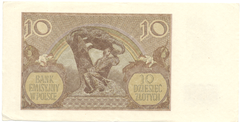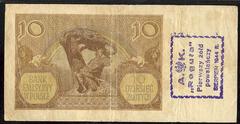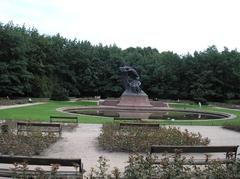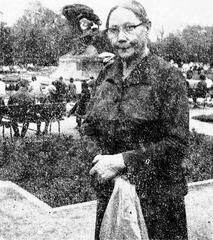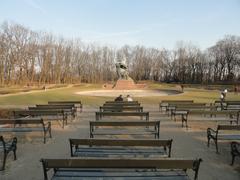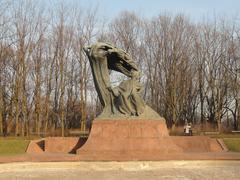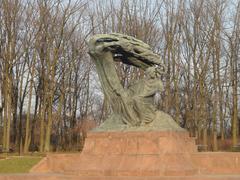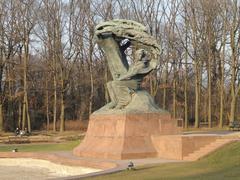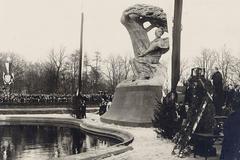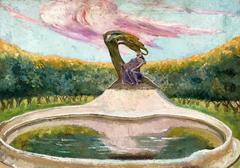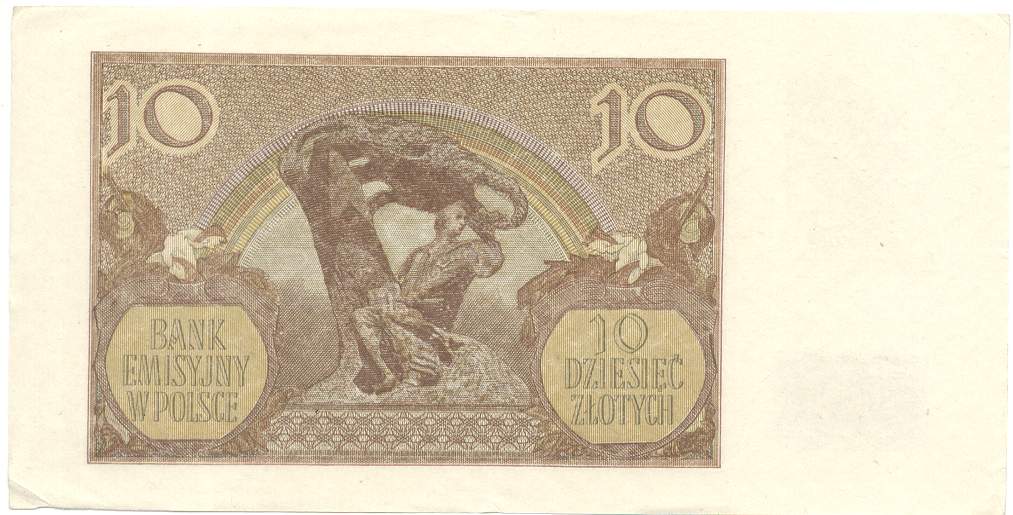
Frederic Chopin Monument Warsaw: Visiting Hours, Tickets, and Travel Guide
Date: 14/06/2025
Introduction
The Frederic Chopin Monument, nestled in Warsaw’s Royal Łazienki Park, stands as a profound symbol of Polish culture, artistic achievement, and resilience. Conceived in the early 20th century to honor Poland’s legendary composer, Frédéric Chopin, the monument weaves together the nation’s turbulent history and its enduring love for music. Today, the site is as much a cultural hub as a historical landmark, attracting classical music enthusiasts, history buffs, and travelers from around the world. This comprehensive guide provides details on the monument’s history, visiting hours, ticket information, accessibility, nearby attractions, and special events, ensuring you make the most of your visit.
Table of Contents
- Historical Background
- Visiting Information
- The Monument’s Role in Polish Identity
- Nearby Attractions
- Visitor Tips and Etiquette
- Frequently Asked Questions (FAQ)
- Visuals and Media
- Plan Your Visit
- References
Historical Background
Origins and Planning
The idea for a monument to commemorate Frédéric Chopin emerged at the turn of the 20th century, championed by the Warsaw Music Society and prominent citizens who wished to honor Chopin’s centenary in 1910 (greatcomposers.nifc.pl). However, bureaucratic delays, funding challenges, and artistic debates postponed the project for years (wikipedia).
Design and Artistic Vision
In 1908, an international competition led to the selection of Wacław Szymanowski’s Art Nouveau design. The monument depicts Chopin in a contemplative pose beneath a stylized, wind-blown willow tree, symbolizing the deep emotion of his music and the resilience of the Polish spirit (warsawinsider.pl). The willow’s form is also interpreted as a pianist’s hand and musical notation. The monument’s red sandstone pedestal and basin, designed by architect Oskar Sosnowski, complete the ensemble (isolatedtraveller.com). The design faced controversy for its modern style and symbolic choices, but public support eventually prevailed.
The monument was finally unveiled in 1926 in the upper part of Łazienki Park, marking a significant cultural milestone for newly independent Poland (its-poland.com).
Wartime Destruction and Reconstruction
World War II brought devastation: the Nazis deliberately destroyed the Chopin Monument in 1940, targeting it as a symbol of Polish culture (polishhistory.pl). During the occupation, Chopin’s music was banned, further underscoring the monument’s significance as a symbol of resistance (monuments-remembrance.eu).
After the war, Poles resolved to rebuild. Thanks to surviving models and photographs, the monument was meticulously reconstructed and unveiled in 1958 (greatcomposers.nifc.pl).
Visiting Information
Hours and Admission
- Opening Hours: The monument is accessible during Royal Łazienki Park’s opening hours, typically from 6:00 AM until dusk (8:00–9:00 PM in summer; earlier in winter). Please check the official Łazienki Park website for seasonal and holiday updates.
- Admission: Entry to the monument and the park grounds is free. Tickets are only required for visiting certain park buildings (such as the Palace on the Isle or Old Orangery).
Accessibility
- The monument area is wheelchair accessible, with paved paths and nearby accessible restrooms.
- Some park areas have uneven terrain; plan accordingly if you have mobility needs.
Directions and Transport
- Public Transport: Multiple bus lines (including 116, 166, and 180) and tram lines stop near Łazienki Park. The closest metro station is ‘Politechnika.’ Use the “Łazienki Królewskie” stop for the shortest walk (warsawvisit.com).
- By Car: Limited street parking is available nearby, but public transport is recommended.
- On Foot/Bike: The park is easily reachable from central Warsaw and along the scenic Royal Route.
Guided Tours & Events
- Summer Chopin Concerts: Free open-air piano concerts are held at the monument every Sunday at 12:00 PM and 4:00 PM from mid-May through September (go2warsaw.pl). Arrive early for the best seating.
- Guided Tours: Book through local agencies or the park’s website. Tours often include the monument, Chopin Museum, and other Chopin-related sites (AB Poland).
The Monument’s Role in Polish Identity
The Frederic Chopin Monument is more than a work of art; it is a focal point of Polish national pride and resilience (Davis Center). Its destruction during World War II and subsequent reconstruction are emblematic of Warsaw’s—and Poland’s—capacity for rebirth. Annual concerts and community gatherings at the monument reinforce its status as a living symbol of cultural continuity (Warsaw Insider).
Nearby Attractions
Łazienki Park is home to several notable landmarks:
- Palace on the Isle: A neoclassical residence on an artificial island.
- Old Orangery and Royal Theatre: Housing theatre and sculpture collections.
- Botanical Garden: Adjacent to the monument, with diverse flora.
- Belweder Palace and Ujazdowski Castle: Important historical sites within walking distance.
Other Chopin-related sites in Warsaw include the Chopin Museum, Holy Cross Church (where Chopin’s heart rests), and musical benches scattered throughout the city (thebudgetsavvytravelers.com).
Visitor Tips and Etiquette
- Concerts: Arrive 30–45 minutes before start time for good seating; bring a blanket or portable seat.
- Weather: Concerts proceed rain or shine—plan accordingly.
- Picnicking: Allowed in the park; the area around the monument is popular for picnics.
- Photography: Permitted, but avoid blocking views during events.
- Accessibility: Paved paths support wheelchair and stroller access.
- Wildlife: Do not feed animals; respect the park’s ecosystem.
- Safety: The park is family-friendly and regularly patrolled; monitor belongings during crowded events.
Frequently Asked Questions (FAQ)
Q: What are the visiting hours for the Chopin Monument?
A: The monument is accessible during Łazienki Park’s hours, typically 6:00 AM to dusk. Check the official website for updates.
Q: Is there an entry fee?
A: No, visiting the monument and park grounds is free.
Q: When are the free Chopin concerts held?
A: Every Sunday at 12:00 PM and 4:00 PM, mid-May through September.
Q: Is the monument area accessible for wheelchairs?
A: Yes, paved pathways lead to the monument and around the park.
Q: How do I get to the monument by public transport?
A: Buses 116, 166, or 180 to the “Łazienki Królewskie” stop; trams and metro also serve the area.
Q: Can I book a guided tour?
A: Yes, tours are available via the park or local operators, often including other Chopin sites.
Visuals and Media
- View images and virtual tours of the monument and park on the official Łazienki Park website.
- For trip planning, use interactive maps and photo galleries found on tourism portals.
Plan Your Visit
- Best season: Late spring through early autumn for concerts and garden blooms.
- What to bring: Comfortable shoes, a picnic blanket, water, and a camera.
- Stay connected: Download the Audiala app for audio guides and event updates. Follow us on social media for more travel tips and cultural content.
References
- Great Composers: Chopin Monument
- Wikipedia: Frederic Chopin Monument, Warsaw
- Warsaw Insider: Chopin Monument
- Polish History: The Frederic Chopin Statue Was Blown Up by the Germans in 1940
- Davis Center at Harvard: Performing the Nation – Chopin Statue and Concerts
- Evendo: Frederic Chopin Monument
- AB Poland: Frederic Chopin Private Tour in Warsaw
- Warsaw Visit: Visiting Frederic Chopin Monument in Łazienki Park
- The Unique Poland: Frederic Chopin Monument
- My Path in the World: Free Things to Do in Warsaw
- In Your Pocket: Chopin Monument
The Frederic Chopin Monument in Warsaw offers a unique opportunity to connect with Poland’s rich cultural heritage in a stunning parkland setting. Whether you are drawn by music, history, or the serene beauty of Łazienki Park, the monument is a must-see highlight of any Warsaw itinerary.
